|
Report from
Europe
UK tropical wood and wooden furniture imports at all
time low
The import value of tropical wood and wooden furniture
into the UK in the first eight months of this year was
USD655 million, 38% less than the same period last year.
In quantity terms, the UK imported 273,400 tonnes of
tropical wood and wooden furniture in the January to
August period, 19% less than the same period last year.
This is an extraordinarily low figure, in tonnage terms the
lowest level of UK tropical wood products imports for the
first eight months of the year since at least the early 1990s,
and probably well before then.
It is 4% below the previous record low which came in the
first eight months of 2013 at the end of one of the longest
periods of economic stagnation on record in the UK. It is
5% less than recorded in the first eight months of 2020
when the country was at a complete standstill at the start
of the COVID pandemic.
Coming as it does after two historically good years for the
UK trade in 2021 and 2022 during the immediate post-
COVID recovery, this is a classic case of boom and bust.
The monthly data shows that the total tonnage of UK
imports of tropical wood and wooden furniture fell to an
extreme low of only 22,000 tonnes in December 2022
before rising to 35,000 tonnes in February 2023.
Since then, imports have barely shifted from this level
which is about 20% below the long-term average for the
time of year (Chart 1).

Mounting signs of stagnation in the UK economy
The extremely slow pace of UK tropical wood and
wooden furniture imports this year is symptomatic of a
wider economic downturn in the country. KPMG’s latest
UK Economic Outlook issued 25th September notes that
“high interest rates, continued uncertainty and low
productivity could see the UK struggle to keep its head
above water in the second half of the year – with GDP
growth forecast at 0.4% in 2023 and 0.3% in 2024”.
KPMG go on to report that “While the labour market is
gradually returning to balance, household excess savings
are broadly used up and the effect of higher interest rates
is now feeding through to investment intentions,
transaction volumes and corporate insolvencies, with the
full impact on households and housing sectors yet to be
felt”.
The Institute for Fiscal Studies (IFS), an independent
thinktank, observes in its latest report on the UK economy
published on 17th October that “UK GDP is still 5.2%
short of its 2012–19 trend: a worse relative performance
than either the United States or the Euro Area where the
shortfalls range between 2% and 3%. The UK economy
remains stuck between weak growth but continued
inflationary risks”.
IFS note that the support previously offered to the UK
economy by COVID recovery measures and falling energy
prices since the heights of last winter are now fading.
Furthermore, credit growth has, in recent months, dropped
to levels only previously observed in the immediate
aftermath of the 2008 Global Financial Crises.
The value of both financial and housing wealth has been
eroded since 2020 by the surge in inflation.
Unemployment has increased from 3.5% in the 2022
trough to 4.3% now.
The signs of resilience in the UK construction sector
reported in the summer months this year have also faded
away. The latest S&P Global/CIPS UK Construction
Purchasing Managers’ Index (PMI) registered 45.0 in
September, down sharply from 50.8 in August and below
the neutral 50.0 value for the first time since June.
Residential work (index at 38.1) was by far the worst
performing area of construction output during September,
followed by civil engineering activity (45.7). Aside from
the pandemic, the latest fall in housing activity was the
steepest since April 2009.
Respondents to the S&P Global/CIPS survey widely
commented on cutbacks to house building projects amid
rising borrowing costs and weak demand conditions.
Commercial building declined at only a modest pace in
September (index at 47.7), but this represented a
considerable setback after the solid growth seen
throughout the summer. Some firms noted that worries
about the economic outlook had dampened client demand
and led to a lack of new work to replace completed
projects.
Sentiment surrounding prospects in the UK construction
sector were a little more positive. According to the S&P
Global/CIPS survey, the number of construction firms
predicting a rise in output over the year ahead (41%)
continued to exceed those forecasting a decline (17%).
This was linked to long-term business expansion plans and
hopes of a turnaround in customer demand.
UK import value of tropical wooden furniture falls
The UK imported USD287 million of tropical wooden
furniture products in the first eight months of 2023, which
is 48% less than the same period last year. In quantity
terms, wooden furniture imports were 77,600 tonnes
during the eight-month period, 32% less than the same
period last year.
In the first eight months of 2023 compared to last year,
UK import value of wooden furniture from Vietnam was
down 46% to USD149 million, Malaysia was down 39%
to USD59 million, India was down 52% to USD31
million, Indonesia was down 45% to USD31 million,
Thailand was down 46% to USD8 million, and Singapore
was down 87% to USD5 million (Chart 2).
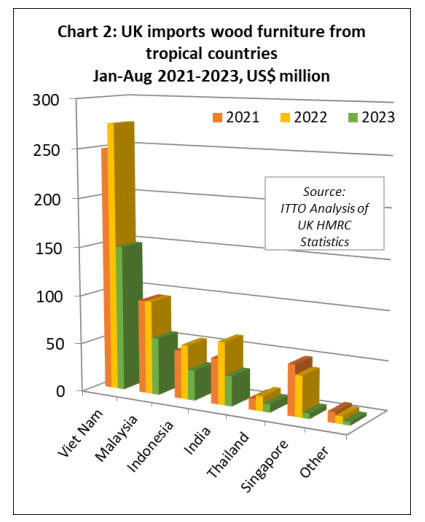
cross the board decline in UK import value of all
tropical wood products
Total UK import value of all tropical wood products in
Chapter 44 of the Harmonised System (HS) of product
codes was USD368 million between January and August
this year, 26% less than the same period in 2022. In
quantity terms imports decreased 12% to 195,800 tonnes
during the period.
Compared to the first eight months of 2022, UK import
value of tropical joinery products decreased 34% to
USD137 million, import value of tropical plywood
decreased 33% to USD85 million, import value of tropical
sawnwood decreased 11% to USD78 million, and import
value of tropical mouldings/decking decreased 23% to
USD19 million (Chart 3).
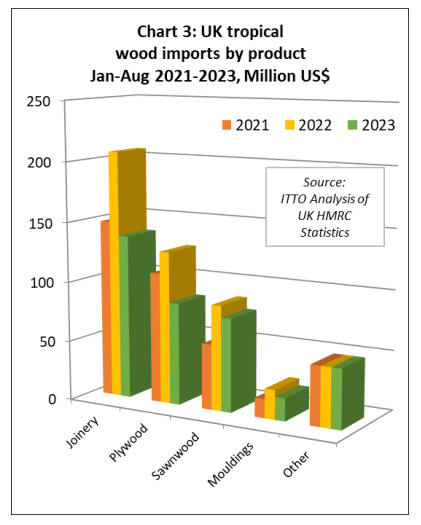
UK import value of joinery products from Indonesia
(mainly doors) was USD69 million in the first eight
months of 2023, down 38% compared to the same period
last year. UK import value of joinery products from
Malaysia (mainly laminated products for kitchen and
window applications) fell 36% to USD18 million during
the same period. UK import value of Chinese tropical
joinery products, nearly all comprising doors, was USD17
million in the January to August period, 33% less than the
same period last year (Chart 4).
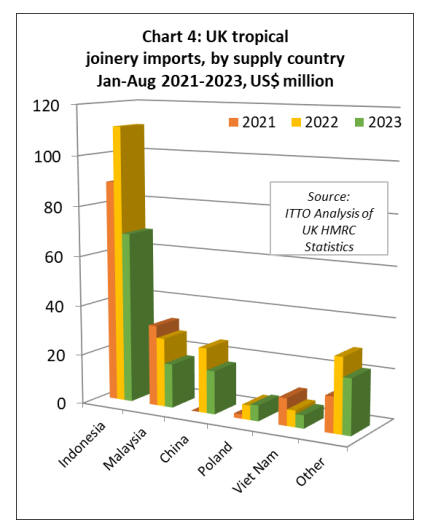
UK direct imports of tropical hardwood plywood offset
by rise from China
In the first eight months of 2023, the UK imported
144,800 cu.m of tropical hardwood plywood, 6% less than
the same period last year. A significant decline in direct
imports of tropical hardwood plywood from tropical
countries partly offset by a rise in imports from China
(Chart 5).
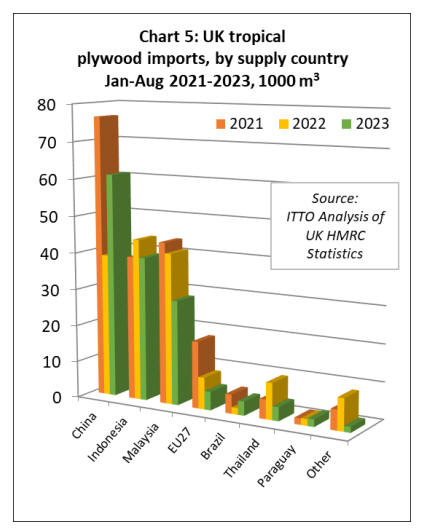
The UK imported 61,000 cu.m of tropical hardwood
plywood from China in the first eight months of 2023,
57% more than the same period last year. Last year, UK
imports of Chinese products faced with tropical
hardwoods fell sharply in favour of Chinese products
faced with temperate hardwoods.
This trend has been reversed in 2023 with China again
shipping a larger proportion of tropical hardwood faced
plywood to the UK. This is likely to at least partly reflect
concern that plywood comprised of Russian birch was
being shipped from China in contravention of UK trade
sanctions imposed following Russia’s invasion of Ukraine.
UK imports of Indonesian plywood in the first eight
months this year were, at 39,200 cu.m, 10% less than the
same period last year. The UK imported 28,500 cu.m of
plywood from Malaysia in the first eight months of 2023,
31% less than the same period last year.
UK plywood imports from Thailand were down 62% to
3,800 cu.m in the first eight months this year. However, in
the same period there was a large percentage increase from
a very small base in tropical hardwood plywood imports
from Brazil (+115% to 3,800 cu.m). Imports from
Paraguay also increased 13% to 2,000 cu.m.
Meanwhile, the combined effects of Brexit, supply
shortages and rising energy and other material costs on the
European continent continue to impact on UK imports of
tropical hardwood plywood from EU countries which were
just 5,000 cu.m in the first eight months of this year, 42%
less than the same period last year.
Rising UK imports of tropical sawnwood from the EU
UK imports of tropical sawnwood were 69,700 cu.m in the
first eight months of this year, 6% less than the same
period in 2022.
Although UK imports of this commodity appear to have
held up reasonably well compared to other tropical
products this year, a larger share has been sourced
indirectly from the EU and not direct from the tropics
(Chart 6).
Furthermore, a large increase in UK imports of tropical
hardwood sawnwood (HS 4407) from Brazil this year is
also offset by a significant decline in imports of Brazilian
tropical hardwood decking/mouldings (HS4409).
Therefore, it may be that reported trends for both
commodities are distorted by changes in the way products
from Brazil are categorized respectively as “sawnwood”
and “mouldings”.

UK imports of tropical sawnwood from Cameroon were
24,500 cu.m in the first eight months of 2023, 6% less
than the relatively high level in the same period in 2022.
UK tropical sawnwood imports from Malaysia, which
revived to some extent last year after many years of
decline, fell by 50% in the first eight months of this year to
6,500 cu.m.
UK imports of tropical sawnwood from Brazil were
reported as 5,400 cu.m in the first eight months of this
year, a gain of 70% compared to the same period in 2022.
Imports also increased from Ghana during the eight-month
period, by 36% to 1,400 cu.m. However, imports from
Republic of Congo fell 16% to 4,100 cu.m. Imports from
Guyana, at 2,100 cu.m were the same as last year.
Indirect UK imports of tropical sawnwood via the EU
recovered ground despite the Brexit disruption, increasing
11% to 19,000 cu.m in the first eight months of 2023. To
some extent, UK’s continuing dependence on indirect
imports of tropical sawnwood from the EU is due to a
shortage of kiln drying space in African supply countries
combined with lack of any hardwood kiln drying capacity
in the UK.
UK imports of tropical hardwood mouldings/decking fell
23% in the first eight months of 2023 to 6,400 tonnes.
Imports of 2,100 tonnes from Indonesia were 35% less
than the same period in 2022.
Imports from Malaysia totalling 1,800 tonnes were down
10% compared to the same period last year. Imports of this
commodity group from Brazil were recorded at less than
300 tonnes in the first eight months of this year, 83% less
than the same period last year.
In contrast, imports increased 99% from the Netherlands
to 1110 tonnes, while imports from Vietnam increased
nearly 6-fold to 500 tonnes from a very small base (Chart
7).
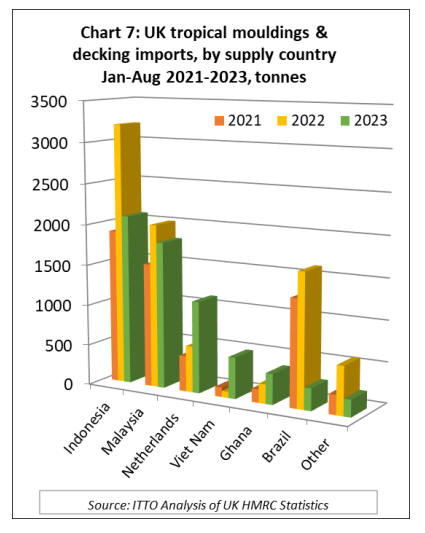
|